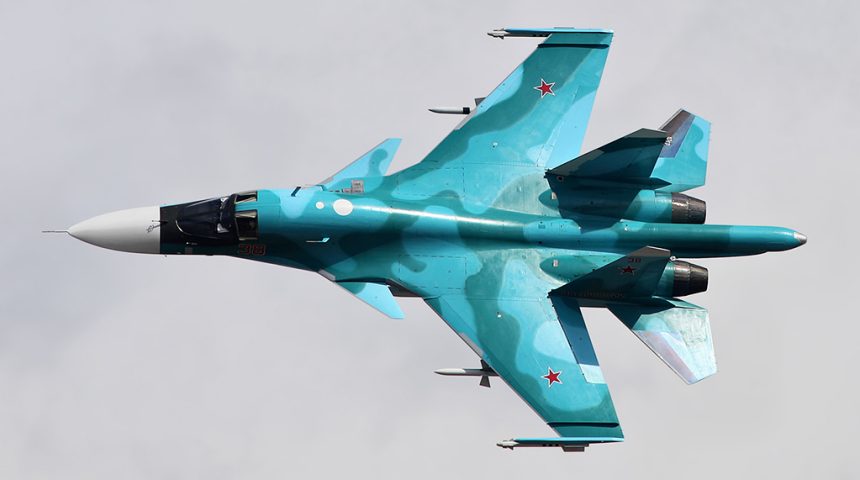Until now, only MiG-31K aircraft were known to have employed the Kinzhal missile in combat.
A Russian Aerospace Forces Su-34 Fullback bomber used the Kinzhal missile against an unknown target in Ukraine, TASS news agency reported on Sept. 4, 2023. “The Su-34 fighter jet used the Kinzhal hypersonic missile in the special military operation. The first crew who successfully accomplished such a task will receive state awards,” a Russian defense official said according to the Russian State-owned media outlet.
This was the first time the air-launched Kinzhal (Dagger) hypersonic missile was used by a Su-34 during Russia’s “special operation” in Ukraine: previously, only MiG-31K were used to carry the hypersonic ballistic missile. Inducted into active service with the Russian Aerospace Forces in 2014, the Su-34 is a two-seat strike fighter with a maximum range of 4,000 km, a payload of up to 12,000 kg on 12 hardpoints, the ability to carry R-77 and and R-73 missiles, a 30 mm GSh-30-1 cannon, and a Khibiny ECM suite. For more details about the aircraft take a look at the infographic we posted here.
Kinzhal is basically an air-launched Iskander-M SRBM (short-range ballistic missile) that uses a MiG-31 Foxhound or Tu-22M3 Backfire assets as an air-breathing first stage to increase its range: in fact, it is not a “hypersonic weapon” (i.e. an air-breathing missile based on scramjet technology) and, as a ballistic missile, it flies at hypersonic speed with a reported cruise missile-like flat flight profile.
All the details about the missile can be found in the article we published here at The Aviationist in 2018, when the missile the Kinzhal was first test-fired:
Kinzhal is claimed to be a strategic air-to-surface strike missile. The missile is claimed to have maneuverable flight characteristics not typically seen in hypersonic, solid fuel missiles. Observers of Russian missile programs have voiced skepticism about Russia’ performance claims however. According to Russians and reference sources the Kinzhal missile has a top speed of Mach 10 and maintains some ability to maneuver throughout its performance envelope including at hypersonic speed. If accurate, these capabilities could make the Kinzhal difficult to intercept by anti-missile systems. The missile is reported to have a range of 1,200 miles (approximately 2,000 kilometers). This, added to the reported 1,860-mile unrefueled range of the MiG-31BM long range, supersonic interceptor, gives the Kinzhal potentially intercontinental strike capability. The missile is also reported to be nuclear-capable and able to hit ground as well as naval targets.
[…]
Hypersonic cruise missiles have the capability to defeat or degrade the effectiveness of most current surveillance and anti-missile systems because of their speed (and, in the case of this new Kinzhal, claimed capability to maneuver). The choice of the aging MiG-31, that would probably launch the Kinzhal from +60,000 feet at supersonic speed, is aimed at giving the tactical ballistic missile much more reach than it would have if launched from the ground: indeed, during the Cold War, the long-range high-altitude interceptor was supposed to be used as launch platform for anti-satellite weapons that could destroy targets in near space. Capable to carry up to four long-range R-33 missiles and four short-range R-77 missiles, not only was the MiG-31BM expected to carry a weapon able to shoot down space satellites; it was also intended to be used as a “cruise missile interceptor”: the Foxhounds have been involved in tests to intercept cruise missiles, previously Kh-55 and more recently Kh-101, for years.
While the Kinzhal appears to be an air-to-ground missile the pairing of this nuclear capable hypersonic missile recalls the much older AIR-2 Genie nuclear armed air-to-air missile with a 1.5 kiloton warhead. The AIR-2 Genie and earlier versions of the same missile were deployed by the U.S. Air Force from 1957-1962.
Kinzhal missiles have already been used several times in the Ukrainian war. The first reported use of the weapon was when Russia said it had fired the missile at a munitions dump in southwestern Ukraine on March 19, 2022. The missile was also used during a massive attack launched by Russia at the Ukrainian energy infrastructure and other targets across Ukraine on March 9, 2023.
In May 2023, Ukraine’s air defense managed to shoot down a Kinzhal for the first time using US-delivered Patriot air-defense systems Kyiv first received in April. Since then, Ukraine has reported downing Kinzhal missiles at least four more times, the last one last month.
While the news of the Kinzhal being used by a Su-34 comes from TASS, a state-run media outlet, there are some Russian sources that say the missile used by the Fullback wasn’t the Kinzhal but an another undisclosed new missile. We’ll see if something more emerges but it’s worth noticing this was the first time the Su-34 was said to be able to carry the large hypersonic weapon.
Interestingly, Fighterbomber claims on his TG channel that a Su-34 employed a new weapon in Ukraine “several days ago,” but that it wasn’t “Kinzhal.” Says he will disclose what it is tomorrow if he is permitted to. pic.twitter.com/chXD4PvLiG
— Guy Plopsky (@GuyPlopsky) September 4, 2023









